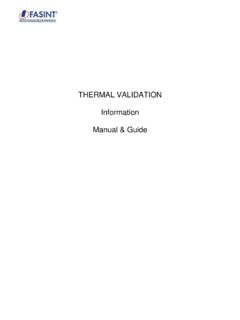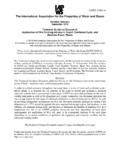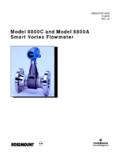Transcription of OPTIMIZATION OF A HIGH-EFFICIENCY JET EJECTOR BY ...
1 OPTIMIZATION OF A HIGH-EFFICIENCY JET EJECTOR BY. computational fluid dynamics software . A Thesis by SOMSAK WATANAWANAVET. Submitted to the Office of Graduate Studies of Texas A&M University in partial fulfillment of the requirements for the degree of MASTER OF SCIENCE. May 2005. Major Subject: Chemical Engineering Page 1 of 14 ABSTRACT. OPTIMIZATION of a HIGH-EFFICIENCY Jet EJECTOR by computational fluid dynamics software . (May 2005). Somsak Watanawanavet, , Chulalongkorn University Co-Chairs of Advisory Committee: Dr. Mark T. Holtzapple Dr. Charles J. Glover Research was performed to optimize HIGH-EFFICIENCY jet EJECTOR geometry (Holtzapple, 2001) by varying nozzle diameter ratios from to , and motive velocities from Mach to The HIGH-EFFICIENCY jet EJECTOR was simulated by Fluent computational fluid dynamics (CFD) software .
2 A conventional finite-volume scheme was utilized to solve two-dimensional transport equations with the standard k-! turbulence model (Kim et. al., 1999). In this study of a constant-area jet EJECTOR , all parameters were expressed in dimensionless terms. The objective of this study was to investigate the optimum length, throat diameter, nozzle position, and inlet curvature of the convergence section. Also, the optimum compression ratio and efficiency were determined. By comparing simulation results to an experiment, CFD modeling has shown high-quality results. The overall deviation was , thus confirming the model accuracy. Dimensionless analysis was performed to make the research results applicable to any fluid , operating pressure, and geometric scale.
3 A multi-stage jet EJECTOR system with a total compression ratio was analyzed to present how the research results may be used to solve an actual design problem. The results from the OPTIMIZATION study indicate that the jet EJECTOR efficiency improves significantly compared to a conventional jet- EJECTOR design. In cases with a subsonic motive velocity, the efficiency of the jet EJECTOR is greater than 90%. A high compression ratio can be achieved with a large nozzle diameter ratio. Dimensionless group analysis reveals that the research results are valid for any fluid , operating pressure, and geometric scale for a given motive-stream Mach number and Reynolds ratio between the motive and propelled streams. For a given Reynolds ratio and motive- stream Mach number, the dimensionless outlet pressure and throat pressure are expressed as Cp and Cpm, respectively.
4 A multi-stage jet EJECTOR system with a total compression ratio was analyzed based on the OPTIMIZATION results. The result indicates that the system requires a lot of high-pressure motive steam, which is uneconomic. A HIGH-EFFICIENCY jet EJECTOR with mixing vanes is proposed to reduce the motive-steam consumption and is recommended for further study. Page 2 of 14 INTRODUCTION. Jet ejectors are the simplest devices among all compressors and vacuum pumps. They do not contain any moving parts, lubricants or seals; therefore, they are considered as highly reliable devices with low capital and maintenance costs. Furthermore, most jet ejectors use steam or compressed air as the motive fluid , which is easily found in chemical plants. Due to their simplicity and high reliability, they are widely used in chemical industrial processes; however, jet ejectors have a low efficiency .
5 Many factors affect jet EJECTOR performance, including the fluid molecular weight, feed temperature, mixing tube length, nozzle position, throat dimension, motive velocity, Reynolds number, pressure ratio, and specific heat ratio (DeFrate and Hoerl (1959); and Kim et al. (1999)). Previous research by Riffat and Omer (2001) and Da-Wen and Eames (1995) attempted to study the effect of nozzle position on jet EJECTOR performance. They found that the nozzle position had a great effect on the jet EJECTOR performance, as it determines the distance over which the motive and propelled stream are completely mixed. ESDU (1986) suggested that the nozzle should be placed between and length of throat diameter before the entrance of the throat section. Holton (1951) studied the effect of fluid molecular weight, whereas Holton and Schultz (1951) studied the effect of fluid temperature.
6 This thesis follows the style of the AIChE Journal. A number of researchers made an effort to understand the effect of jet EJECTOR geometry on jet EJECTOR performance. For example, Kroll (1947) investigated the effect of convergence, divergence, length, and diameter of the throat section, nozzle position, induced fluid entrance, and motive velocity. Croft and Lilley (1976). investigated the optimum length and diameter of the throat section, nozzle position, and angle of divergence. A few literature researchers have studied the effect of nozzle diameter on jet EJECTOR performance. This is a major focus of our proposal. The optimum length and diameter of the throat section, the nozzle position, and the radius of the inlet curvature before a convergence section in a constant-area jet EJECTOR design are investigated for each individual nozzle diameter.
7 The nozzle diameter ratio, defined by Dn/Dp, is varied from to The motive velocity at nozzle exit is varied from Mach to The back pressure of the EJECTOR is maintained constant at kPa. Steam is used as a working fluid . In this research, the optimum jet- EJECTOR geometry for each nozzle diameter ratio and motive velocity was investigated using Fluent computational fluid dynamic (CFD) software . CFD software has been proved by a number of researchers (Riffat and Everitt, 1999; Hoggarth, 1970; Riffat et al., 1996; Talpallikar et al., 1998;. Neve, 1993) as a powerful tool for predicting flow fields inside jet ejectors. Fluent uses a mass-average segregated solver to solve the fundamental transport equations such as continuity, momentum conservation, and momentum conservation for incompressible, Newtonian fluid (the Navier-Stokes equation).
8 The governing equations are discretized in space using a finite volume differencing formulation, based upon an unstructured grid system. The standard k-! turbulent method is employed to solve the governing equations. The reliability of CFD modeling is examined by comparing a simulation result with an experiment result, which was done by Manohar Vishwanathappa, a graduate chemical engineering student at Texas A&M University. The deviation between both results is , thus confirms the model reliability. Finally, a multi-stage jet EJECTOR system with a total compression ratio is analyzed to demonstrate the implementation of the research to solve an actual design problem. Page 3 of 14 OBJECTIVES. The main objective of this research is to optimize the geometry of a conventional constant-area jet EJECTOR design using Fluent CFD software .
9 The research varies motive velocity and nozzle diameter ratio. There are four specific research goals in this OPTIMIZATION study: 1. Determine the optimum entrainment ratio. 2. Optimize the throat section, including the length and diameter, the nozzle position, and the radius of inlet curvature before the convergence section. 3. Evaluate the dimensionless pressure of the propelled stream and motive stream, and the efficiency of the optimum design. 4. Analyze a multi-stage jet EJECTOR system with compression ratio based on the research results. The second objective is to verify the reliability of CFD modeling. There are three specific research goals: 1. Verify the accuracy of CFD modeling by comparing a simulation result with an experimental result, which was done by Manohar Vishwanathappa, a graduate chemical engineering student at Texas A&M University.
10 2. Determine the effect of grid size by comparing between a coarser and a finer grid-size model with various numbers of iterations. 3. Verify the CFD model consistency by studying the effect of potential boundary conditions on simulation results. By working closely with Ganesh Mohan, a graduate mechanical engineering student at Texas A&M University, the third objective is to implement dimensionless group analysis in the research. The specific research goal follows 1. Investigate a fluid dimensionless variable to make the research result valid for any fluid , operating pressure condition, and geometric scale. LITERATURE REVIEW. Design and OPTIMIZATION In the past, when engineers designed jet ejectors, either a rule-of-thumb or trial-and-error approach was used.







